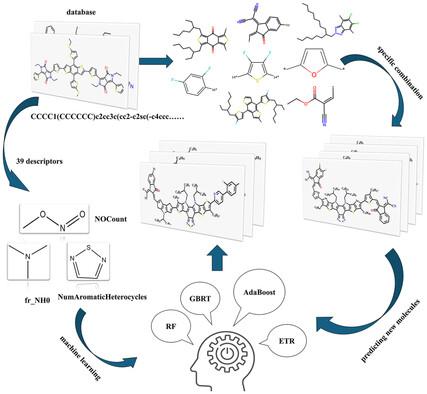Our official English website, www.x-mol.net, welcomes your
feedback! (Note: you will need to create a separate account there.)
Molecular Design and High-Throughput Virtual Screening of Electron Donor and Non-fullerene Acceptors for Organic Solar Cells
Solar RRL ( IF 6.0 ) Pub Date : 2024-06-30 , DOI: 10.1002/solr.202400370 Rui Cao 1 , Cai-Rong Zhang 1 , Ming Li 1 , Xiao-Meng Liu 1 , Mei-Ling Zhang 1 , Ji-Jun Gong 1 , Yu-Hong Chen 1 , Zi-Jiang Liu 2 , You-Zhi Wu 3 , Hong-Shan Chen 4
Solar RRL ( IF 6.0 ) Pub Date : 2024-06-30 , DOI: 10.1002/solr.202400370 Rui Cao 1 , Cai-Rong Zhang 1 , Ming Li 1 , Xiao-Meng Liu 1 , Mei-Ling Zhang 1 , Ji-Jun Gong 1 , Yu-Hong Chen 1 , Zi-Jiang Liu 2 , You-Zhi Wu 3 , Hong-Shan Chen 4
Affiliation

|
The complicated trilateral relationships among molecular structures, properties, and photovoltaic performances of electron donor and acceptor materials hinder the rapid improvement of power conversion efficiency (PCE) of organic solar cells (OSCs). Herein, the database of 310 donor and non-fullerene acceptor pairs is constructed and 39 molecular structure descriptors are selected. Four kinds of machine learning (ML) algorithms random forest (RF), extra trees regression, gradient boosting regression trees, and adaptive boosting are applied to predict photovoltaic parameters. The coefficient of determination, Pearson correlation coefficient, mean absolute error, and root mean square error are adopted to evaluate ML performance. The results show that the RF model exhibits the best prediction accuracy. The Gini important analysis suggests the fused ring and aromatic heterocycles are critical fragments in determining PCE. The molecular unit sets are constructed by cutting each donor and acceptor molecules in database. The 31 752 D-π-A-π type donor molecules and 5 455 164 A-π-D-π-A type acceptor molecules are designed by recombination of molecular units, and 173 212 367 328 donor–acceptor pairs are generated by combining the newly designed donor and acceptor molecules. Based on the predicted PCE using the trained RF model, 42 donor–acceptor pairs exhibit the predicted PCE > 16%, in which the highest PCE is 16.24%.
中文翻译:

有机太阳能电池电子供体和非富勒烯受体的分子设计和高通量虚拟筛选
电子给体和受体材料的分子结构、性质和光伏性能之间复杂的三边关系阻碍了有机太阳能电池(OSC)功率转换效率(PCE)的快速提高。在此,构建了 310 个供体和非富勒烯受体对的数据库,并选择了 39 个分子结构描述符。应用随机森林(RF)、额外树回归、梯度提升回归树和自适应提升四种机器学习(ML)算法来预测光伏参数。采用决定系数、皮尔逊相关系数、平均绝对误差和均方根误差来评估机器学习性能。结果表明,RF模型表现出最好的预测精度。基尼重要分析表明稠环和芳香杂环是确定 PCE 的关键片段。通过切割数据库中的每个供体和受体分子来构建分子单元集。通过分子单元重组设计了31 752个D-π-A-π型供体分子和5 455 164个A-π-D-π-A型受体分子,组合生成173 212 367 328个供体-受体对新设计的供体和受体分子。基于使用训练的 RF 模型预测的 PCE,42 个供体-受体对的预测 PCE > 16%,其中最高的 PCE 为 16.24%。
更新日期:2024-06-30
中文翻译:

有机太阳能电池电子供体和非富勒烯受体的分子设计和高通量虚拟筛选
电子给体和受体材料的分子结构、性质和光伏性能之间复杂的三边关系阻碍了有机太阳能电池(OSC)功率转换效率(PCE)的快速提高。在此,构建了 310 个供体和非富勒烯受体对的数据库,并选择了 39 个分子结构描述符。应用随机森林(RF)、额外树回归、梯度提升回归树和自适应提升四种机器学习(ML)算法来预测光伏参数。采用决定系数、皮尔逊相关系数、平均绝对误差和均方根误差来评估机器学习性能。结果表明,RF模型表现出最好的预测精度。基尼重要分析表明稠环和芳香杂环是确定 PCE 的关键片段。通过切割数据库中的每个供体和受体分子来构建分子单元集。通过分子单元重组设计了31 752个D-π-A-π型供体分子和5 455 164个A-π-D-π-A型受体分子,组合生成173 212 367 328个供体-受体对新设计的供体和受体分子。基于使用训练的 RF 模型预测的 PCE,42 个供体-受体对的预测 PCE > 16%,其中最高的 PCE 为 16.24%。

















































 京公网安备 11010802027423号
京公网安备 11010802027423号